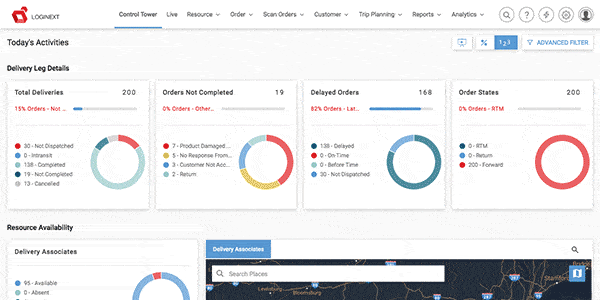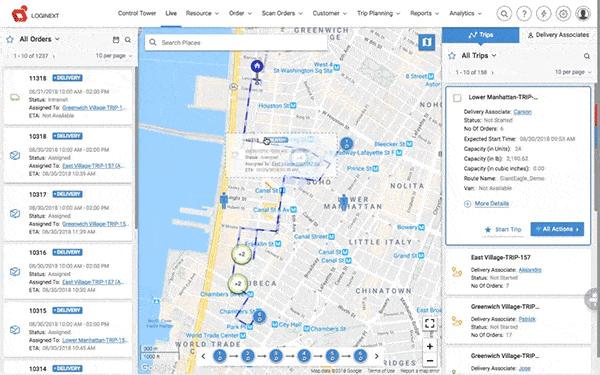
Top CIO Checklist for Optimizing Logistics Management
Technology is moving fast. Businesses and customers today are keener on using the latest tech to simplify daily activities and operations. The expectation is of automation, that technology would solve all conceivable problems, providing the most feasible solution. With cloud technology and the development in machine learning, the computing and analytical power available to us has increased multifold.
The application of this power is where companies create benefits for customers and themselves. At LogiNext, we use machine learning enabled capacity, schedule, and route planning to improve logistics movement for enterprises around the world.
How Does Tech Help in Improving Traditional Logistics Management?
This is where the domain of creating value within logistics significantly grows to bring in the expertise of the CIO. Logistics is no longer just about moving from point A to point B.
It’s about moving point A to point through point C and picking up returns at point D; all this while, avoiding local traffic to save time and fuel, moving through smaller distances and reaching the desired drop off/pickup points on-time, providing complete tracking visibility to the stakeholders like the supervisor and the customer.
Logistics management has outgrown manual processing and execution. And hence, the CIO intervenes.
Here’s what a CIO should look for while planning to enhance their logistics movement.
The Planning that Goes In

As we mentioned before, logistics management has moved up from manual calculations. Shipment movement has become more complicated and dynamic in the past half of the decade. With customers demanding faster and more secure deliveries right at their doorstep, the entire supply chain has pulled up its socks to make that happen.
Service level agreements have become more sensitive and stringent for primary, secondary, and transport distribution legs. Vehicle capacity and delivery schedules must be better managed to match the increasing volume being transported without losing time or money.
Territory Mapping
This can be done with enhanced planning using the latest in machine learning capabilities. Territories can be mapped virtually within our systems. Companies can identify past order frequencies and key demographics to demarcate areas.
It can also be done by creating a ‘Route Snapshot’. This snapshot takes into consideration historical logistics movement records and maps the average distance traveled by delivery associates. With last mile deliveries, the average distance traveled between a hub and a delivery point can be minimized. When ideal delivery networks are mapped around different hubs, the company would know which order should go to which hub to minimize the turnaround time for the delivery associate.
This is a great way to build heuristics to improve the quality and speed of future logistics planning.
Delivery Resource Management
Each person is unique, we know this much. The same is true for delivery associates and drivers. Their learning curve and knowledge along with vehicle, order, and client/customer handling skills are different. The system should plan better delivery schedules by factoring in all these unique features. It’s all about assigning the right order or shipment to the right delivery associate. The ‘right’ here means the person best suited to satisfactorily delivery the order; quicker and safer.
Recommended Read: Win The Last Mile With The Right Tech And Highly-Motivated Drivers
This logic also extends to vehicles. There are many different types of vehicles, owned or rented, with varying capacities and functionalities.
Based on the delivery volume, the system should optimize the available capacity for best use (leading to lesser vehicles used, and those used, are used efficiently).
Automated Allocation
The system automatically allocates an order or shipment to the best-suited delivery associate and vehicle. Their capacity and schedule optimized to reduce turnaround time and distance traveled without comprising on any service level agreements. Companies no longer would have to wonder whether they could have saved or delivered more. They would know that given the current resource and time restraints, they functioned at the most optimal level.
Some key system architecture elements which ensure that such logistics planning reached desired fruition without interruption:

| Scalability | Reliability | Manageability |
| The system should be scalable so that seasonal peaks or random flux in incoming and outgoing orders should be handled without downtime or unforeseen incidents. | The system should be reliable enough to deliver consistent and dependable results each time the planning and scheduling work (while gradually improving the results using reinforced learnings) | The system should have a self-check (dynamic system configuration) mechanism which ensures that the quality and health of all the processes (running within) and sustained. |
The Dynamic Touch

We know that there are many moving parts within logistics management which need to be covered. The complexity of bringing a sense of continuity and control across all such variables is easier handled with cloud-based route planning. Handling dynamism is where machine learning and internet of things play their biggest role.
Route Planning
Planning proper delivery routes is critical to keeping down logistics costs while making on-time deliveries. Due to the dynamic element of route planning, it’s important to understand the live traffic and weather patterns along the route. This part of the planning should be done right at-the-moment of dispatch. It enhances the accuracy of the plans.
The system gives the fastest route which covers all the scheduled deliveries with minimal delays. Even when ad-hoc pickups requests or returns come in from the client’s/customer’s end, they are automatically plugged into the existing route, with minimal deviation or disruption. The auto-allocation engine for pickups should even run on live routes.
Recommended Read: Why Is ‘Right Logistics Tech’ The Only Way To Compete In This High-Demand ‘Amazon’ World
Such focus on route planning leads to shorter turnaround times while covering more deliveries per trip. The upside to this is that resources (delivery associates, drivers, and vehicles) are utilized better, normalizing their time and movement costs.
Dynamic ETAs
As suggested above, route planning has a dynamic element which is perfected at the time of dispatch considering multiple variables. Hence, the estimated time of arrivals should be calculated at the time of dispatch. This means that the supervisor, delivery associate, and client/customer would know the exact time when the order would be delivered and not just a broad ballpark figure.
Even when ad-hoc pickups and returns are plugged into live routes with the auto-allocation engine, the subsequent ETAs are updated dynamically and communicated to the relevant people.
Instant Communication
One essential factor for logistics management is to ensure instant communication covering delivery status updates, delays, customer address updates, etc. Such clarity of on-ground operations adds credibility to the system.
Imagine that there is some unexpected event which delayed a specific delivery. This holds the risk of customer irritation and dissatisfaction. However, if the system itself immediately automatically informs the customer about the delay, he or she is better prepared to process the delay (as it doesn’t involve the surprise element of not receiving the package when expected).
The managers should also be able to chat (encrypted) with their delivery associates in real-time from within the system, avoiding the need to switch to a public messenger to forward sensitive information.
These are the key element which streamlines the dynamism of logistics management.

| Usability | Availability | Portability |
| The system should be easy-to-use and decipher for all users, directing them through important processes without distraction. The design should be intuitive to make adoption simple and fast. | The system should be ‘available’ at all times and geographies with minimal downtime. Any possible downtime should be scheduled at the point of least usage. | The system should be equally and easily ‘available’ across multiple platforms (web, mobile, tab), browsers, integrations, modules, etc. The usability across all platforms should be consistent. |
The Control and Precision
![]()
To round off the tech-enablement of the logistics processes, the CIO should ensure that the system is consistent and secure across all plans over a long period of time, sustaining the same (or better) quality of results. The control and precision enacted by the system would help in ensuring such consistency.
End-to-End Visibility
The stakeholders, especially the logistics managers should have complete visibility of all delivery movement within one single system. It’s up to the CIO to ensure that the managers have this visibility to take faster and better decisions. With live tracking of all moving resources, the system can show the exact location, the direction of movement, speed, and whether the planned deliveries are on schedule.
Recommended Read: Simple Guide To Perfect Change Management For SaaS Software
All these tracking elements can be preset with triggers so that the managers are informed whenever any anomaly or ‘exception’ occurs. An exception, in logistics management, is when the resource (associate, driver, or vehicle) deviates from the allocated plan.
All in all, it is the final overlay of control which gives the managers the ability to remotely direct and track all their assets and merchandise.
Delivery Validation
Planning and validation go hand in hand. Validation of deliveries as they happen is important as it gives the supervisors and managers the ability to be on top of all on-ground activities. Electronic authentication of handovers (with images and signatures) helps digitize and automate documentation while ensuring error-free processing. It’s also important to have instant online and offline syncing. This way the managers would have immediate access to all these documents, eliminating the chance of data/information loss.
All this helps with lowering the reaction time for companies. This means that the managers can take timely corrective measures wherever required to avoid dire and irreversible situations.
Here are few key elements which bring in the consistency and stability of any logistics technology.

| Security | Extensibility | Maintainability |
| The system should be absolutely secure while handling user and customer data. This is one of the most important elements to be considered. It is important to sustain the confidentiality and integrity of the system. | The system should be able to add functionalities, customization, and enhancement without causing disruption (enabled with lower coupling and encapsulation). | The system should allow fixing of errors of flaws without causing changes or alterations in any process or function. It is enabled with modularity, documentation, and timely regression analysis. |
The current path of logistics optimization demands a keen interest of the CIO, and this article is directed to bring them up-to-date with the benchmarks they should look for, paving the way for better business opportunities.
247







@LogiNext